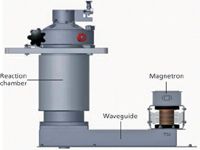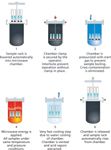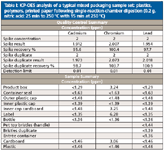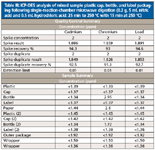Optimizing the Sample Preparation of Metals: Single-Reaction-Chamber Microwave Digestions for Contract Analytical Laboratories
Contract analytical laboratories use a variety of instrumentation for trace-metal analysis and must take advantage of method standardization whenever there is an opportunity.
Contract analytical laboratories use a variety of instrumentation for trace-metal analysis and must take advantage of method standardization whenever there is an opportunity. To ensure high quality data and a standard operation for a variety of industrial samples, these laboratories use microwave digestion for sample preparation before inductively coupled plasma–optical emission spectrometry (ICP-OES) or ICP–mass spectrometry analysis. This article describes optimized single-reaction-chamber microwave digestion methods, including vessel selection, sample size, and temperature profiles, along with ICP-OES data.
The on-demand priorities and round-the-clock nature of commercial testing laboratories often require innovative solutions to meet client demand while maintaining high data quality. Laboratory capability has become even more critical with the increased complexity of sample ranges from multiple industries, including consumer products, clinical samples, pharmaceuticals, and fine chemicals. A combination of capabilities and diverse instrumentation will allow a contract laboratory to include development and validation of methods for material components such as polymers, metals, foils, inks, adhesives, labels, liners, seals, coatings, toys, food, and active pharmaceutical ingredients. Without question, the goal is to find a flexible, easy-to-use sample preparation approach that is coupled with the capability of determining any element over wide concentration ranges. Standardizing multielement sample preparation to include little or no method development, higher temperature and pressure flexibility, the capability of processing mixed sample batches and a variety of acid combinations simultaneously, and the option of disposable vials offers increases in laboratory productivity to match fast analysis turnaround times.
Conventional closed-vessel microwave digestion has been recognized for the past two decades as the most effective technique for the digestion of the widest range of sample types in metals analysis, largely because of its ability to operate at high temperatures and pressures. Because the digestions are in a closed vessel, cross-contamination and the loss of volatile elements are eliminated (1). Additionally, microwave sample preparation techniques have overcome challenges of poor digestion quality by providing better digests with low residual acidity, lower carbon content, and lower concentrations of dissolved solids, a critical feature necessary for back-end inductively coupled plasma–mass spectrometry (ICP-MS) and optical emission spectrometry (ICP-OES) analysis (2). It has been recently suggested that an ideal sample preparation procedure would be capable of digesting large sample amounts, provide high throughput, be compatible with multielement analysis, and be safe, green, and easy to use (3). Unfortunately, in the context of commercial high-throughput laboratories, conventional closed-vessel microwave digestion has limitations, such as an intense amount of labor dedicated to vessel cleaning and vessel assembly and disassembly (1). The most significant limitation comes from the conventional closed-vessel approach's inability to process incoming samples simultaneously; samples must be batched by sample type and acid combination. Given the high demand of contract laboratory environments, there has been a heavy emphasis on improving the technology for sample preparation.
Experimental
Methods and Materials
Single-reaction-chamber microwave digestion is a relatively new closed-vessel technology that is different from traditional designs that include multiple closed-vessels inside a cavity (4). The single-reaction-chamber system uses a large, pressurized reaction chamber where all samples are digested simultaneously. Through this approach the chamber itself is the microwave cavity, enabling high microwave energy and distribution. It also provides an opportunity to place multiple vials in the closed system and eliminates the need to rotate samples during a digestion program. The chamber is prepressured with inert gas, providing a virtual cap and raising the boiling point of any acids used during a digestion run. The most critical result of prepressurization is that it enables different sample types and different acid combinations to be processed in a single operation by placing samples in PTFE, quartz, or disposable glass vials and loading them into an autosampler rack set to fit the chamber.
In addition to the benefits of mixed-sample batches, no loss of volatile elements, the elimination of vessel assembly and an option of using disposable glass vials, this single-reaction-chamber design can operate at very high temperatures and pressures — up to 300 °C and 199 bar, respectively. Laboratories can now digest more difficult samples with a standardized approach consisting of the following steps: with any incoming sample (mix of easy and difficult), determine the sample weight; choose the type of vial, acid combination, temperature, and time of digestion; and analyze. This article details these key criteria for routine use of single-reaction-chamber microwave digestion in a commercial contract laboratory. Detailed review of the capabilities and use of this technique can be found in several recent accounts (1,2,4).

Figure 1: Single-reaction-chamber microwave digestion.
All digestions were developed using an UltraWave microwave oven (Milestone) based on a single-reaction chamber design (Figure 1). The oven delivers 1500 W of microwave power to a 1-L chamber that can hold sample racks with 5, 15, or 22 vessels depending on the sample and volume. Direct temperature and pressure control of the chamber provides direct control of each sample (all samples reach the same temperature and pressure). A schematic flow diagram of the system's operation is shown in Figure 2. The experiments described in this article were performed with a 15-position rack and 15 (15-mL) disposable glass vials.

Figure 2: Schematic flow diagram of single-reaction-chamber microwave operation.
An iCAP 6300 Duo ICP-OES system (Thermo Scientific) composed of an EMT Duo quartz torch, a cyclonic glass spray chamber, and a Burgener nebulizer was used for the analysis of Cd, Cr, and Pb in all packaging sample matrices (for sample digestion with HF, a ceramic torch, alumina injector, and PTFE nebulizer and spray chamber is used). The operating conditions for the ICP-OES system were as follows: RF applied power to the torch, 1.15 kW; auxiliary flow rate, 0.5 L/min; nebulizer flow rate, 0.65 L/min; maximum integration time, 30 s, with dual radial–axial view.
Microwave Sample Preparation
Incoming samples for this study included packaging components containing plastics, polymers, printed paper, and cardboard. Routine contract testing also includes food items and enamels, paint, and epoxy for commercial jewelry. A microwave method was developed that would provide a complete digestion of the full range of incoming sample types, with adjustments to the acid combination to account for jewelry or samples of a siliceous nature.
Typical packaging samples (0.2 g) were placed in disposable glass test tubes and placed in a 15-position rack for the microwave. The samples were treated with a 5-mL nitric acid, 0.5-mL hydrochloric acid combination and the rack was placed in the microwave chamber (note: the PTFE liner contains 110 mL of water and 10 mL of hydrogen peroxide as the microwave load for parameter control). Following prepressurization of the chamber with nitrogen to 40 bar, the samples were digested using the following time–temperature microwave method: Ramp to 250 °C over 20 min, hold at 250 °C for 15 min, cool to 60 °C, and depressurize the chamber for analysis; the total time was 50 min. To achieve complete digestions for all sample types, two method development digestion runs were performed at 225 °C and 240 °C before the optimized temperature was determined.
An example of a typical profile for the microwave method is shown in Figure 3. All parameters are displayed in real time to ensure high quality, safety, and control. For mixed batches, it is critical that the method account for all sample types. As an example for highly organic samples that are encountered in packaging materials, high-temperatures are needed for complete digestion; however, significant pressures are generated during the decomposition. During the course of method development for plastic packaging, pressures often reached 100 bar or greater, indicating the importance of choosing conditions that will digest all sample types simultaneously.

Figure 3: Mixed-batch single-reaction-chamber microwave digestion run.
Results
Three separate microwave digestion runs were performed with a variety of mixed packaging samples from commercial sources. Each of the methods described above formed a clear digest, which was diluted with deionized water to 25 mL. These samples were analyzed for Cd, Cr, and Pb using the ICP-OES system. For quality control (QC), laboratory blank, control spikes, and duplicates were analyzed as part of ongoing instrument continuing calibration verification to go along with periodic sample duplicates. Quantitative data, detection limits, and QC data are shown in Tables I, II, and III. By examining the results it was easy to determine packaging that required subsequent testing and flagging for the customer.

Table I: ICP-OES analysis of a typical mixed packaging sample set: plastics, polymers, printed paper following single-reaction-chamber digestion (0.2 g, nitric acid: 25 min to 250 °C with 15 min at 250 °C)
Given the high-throughput nature of client demand, the standardization of the single-reaction-chamber microwave method aligned well with the use of ICP-OES analysis for a majority of incoming samples. The use of disposable glass vessels, ACS-grade acid and small sample sizes provided a cost effective approach for microwave digestion and ICP-OES analysis. A switch to PTFE or quartz vessels and trace-level acid provides for a path for coupling microwave digestion and ICP-MS analysis for other element panels and lower concentration ranges.

Table II: ICP-OES analysis of mixed sample packaging, containers, and lids following single-reaction-chamber microwave digestion (0.2 g, 5 mL nitric acid and 0.5 mL hydrochloric acid: 25 min to 250 °C with 15 min at 250 °C)
Conclusion
Single-reaction-chamber microwave digestion in commercial contract environments for trace metals provided an optimized sample preparation method. To achieve complete digestion for all sample ranges simultaneously, an optimized temperature of 250 °C was used following two method development iterations at 225 °C and 240 °C. The packaging sample digestions were performed in disposable glass vials to eliminate the need for vessel cleaning in subsequent digestion runs. With a 15-position rack and a 50-min digestion time, three sets of 12 customer samples, blank, and control spike samples and duplicates were digested and analyzed in a normal working day. Standardizing the single-reaction-chamber method with an optimized temperature and choice of vessel material and acid combination enables commercial laboratories to process any combination of customer samples without extensive method development, batching, or vessel cleaning and assembly.

Table III: ICP-OES analysis of mixed sample plastic cap, bottle, and label packaging following single-reaction-chamber microwave digestion (0.2 g, 5 mL nitric acid and 0.5 mL hydrochloric acid: 25 min to 250 °C with 15 min at 250 °C)
References
(1) T. Michel, Amer. Lab. 42, 32–35 (2010).
(2) J.A. Nobrega, C. Pirola, L.L. Fialho, G. Rota, C.E.K.M.A de Campos Jordao, and F. Pollo, Talanta 98, 272–276 (2012).
(3) J.A. Norbrega and G.L. Donati in Encyclopedia of Analytical Chemistry, R.A. Meyers, Ed. (John Wiley, Chichester, 2011).
(4) T. Michel and S. Hussain, Spectroscopy supplement Applications of ICP & ICP-MS Techniques for Today's Spectroscopists, 30–35 (November 2012).
David Gunn is the applications/product development manager at Milestone Inc. in Shelton, Connecticut. Arshad Kokardekar is the applications chemist at Milestone Inc. Direct correspondence to: d.gunn@milestonesci.com

Inside the Laboratory – The Petrochronology Group at University of California, Santa Barbara
January 29th 2024In this edition of “Inside the Laboratory,” John Cottle, PhD, a professor of geology at the University of California, Santa Barbara, and a member of Spectroscopy’s Editorial Advisory Board, discusses his group’s most recent work using “laser ablation split steam” analysis to measure elemental concentrations and isotopic ratios in rocks and minerals.